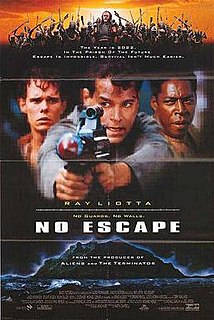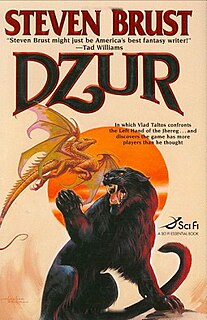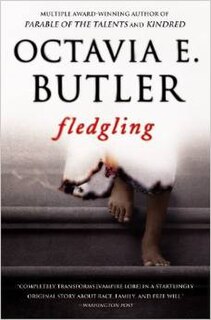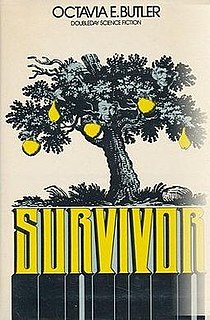
Octavia Estelle Butler was an American science fiction author and a multiple recipient of the Hugo and Nebula awards. In 1995, Butler became the first science-fiction writer to receive a MacArthur Fellowship.

Sign of the Unicorn is a fantasy novel by American writer Roger Zelazny, the third book in the Chronicles of Amber series. It was first published in serial format in Galaxy Science Fiction.
The Amtrak Wars is a series of novels written by British author Patrick Tilley. The series is a post-apocalyptic science fiction with some fantasy elements such as the existence of magic. Six novels and an illustrated companion guidebook were published between 1983 and 1990, with additional books planned but never completed. The books have been optioned by an Australian production company with the intent of turning them into a series of feature films.

Slan is a science fiction novel by American-Canadian writer A. E. van Vogt, as well as the name of the fictional race of superbeings featured in the novel. The novel was originally serialized in the magazine Astounding Science Fiction. It was subsequently published in hardcover in 1946 by Arkham House, in an edition of 4,051 copies. In 2016, Slan was awarded the Retro-Hugo Award for Best Novel for 1941.

No Escape, released in some countries as Escape from Absolom and Absolom 2022, is a 1994 American science fiction action film directed by Martin Campbell. It stars Ray Liotta, Lance Henriksen, Stuart Wilson, Kevin Dillon, Michael Lerner and Ernie Hudson. It was based on the 1987 novel The Penal Colony by Richard Herley. In a dystopian future, a former Reconnaissance Marine serves life imprisonment on an island inhabited by savage and cannibalistic prisoners.
In The Chronicles of Amber series of fantasy novels, The Pattern is an inscribed labyrinth which gives the multiverse its order. It granted characters walking through it "the ability to access a multitude of compossible worlds". Related to it is the Logrus, a shifting, three-dimensional maze which represents the forces of Chaos in the multiverse.

Parable of the Sower is a 1993 science fiction novel by American writer Octavia E. Butler. It is a post-apocalyptic science fiction novel that provides commentary on climate change and social inequality. The novel follows Lauren Olamina, a young woman who can feel the pain of others and becomes displaced from her home. Several characters from various walks of life join her on her journey north and learn of a religion she has crafted titled Earthseed. In this religion, the destiny for believers is to inhabit other planets. Parable of the Sower was the winner of multiple awards, including the 1994 New York Times Notable Book of the Year, and has been adapted into a concert and a graphic novel. Parable of the Sower has influenced music and essays on social justice.

Parable of the Talents is a science fiction novel by American writer Octavia E. Butler, published in 1998. It is the second in a series of two, a sequel to Parable of the Sower. It won the Nebula Award for Best Novel.

Lilith's Brood is a collection of three works by Octavia E. Butler. The three volumes of this science fiction series were previously collected in the now out-of-print volume Xenogenesis. The collection was first published under the current title of Lilith's Brood in 2000.

The Patternist series is a group of science fiction novels by Octavia E. Butler that detail a secret history continuing from the Ancient Egyptian period to the far future that involves telepathic mind control and an extraterrestrial plague. A profile of Butler in Black Women in America notes that the themes of the series include "racial and gender-based animosity, the ethical implications of biological engineering, the question of what it means to be human, ethical and unethical uses of power, and how the assumption of power changes people."

Kindred is a novel by American writer Octavia E. Butler that incorporates time travel and is modeled on slave narratives. First published in 1979, it is still widely popular. It has been frequently chosen as a text for community-wide reading programs and book organizations, as well as being a common choice for high school and college courses.

Dzur is a fantasy novel by American writer Steven Brust, the tenth book of the Vlad Taltos series, originally published in 2006 by Tor Books. It takes place immediately after Issola, the previous novel. The novel was originally intended to be called Tiassa, after another Dragaeran House. The book entered The New York Times Bestseller list for Hardcover Fiction on August 22, 2006.

Sole Survivor is a novel by the best-selling author Dean Koontz, published in 1997. It is about a woman named Rose, who is being pursued by a company called Teknologik. It was adapted into the 2000 film Sole Survivor.

Deceit is an original novel written by Peter Darvill-Evans and based on the long-running British science fiction television series Doctor Who. It features the Seventh Doctor, Ace and Bernice. Also included is Doctor Who Magazine comic character Abslom Daak, in his first appearance outside DWM. A prelude to the novel, also penned by Darvill-Evans, appeared in Doctor Who Magazine #198.

The Singer of All Songs is the first novel in the Chanters of Tremaris trilogy by Kate Constable.

Fledgling is a science fiction vampire novel by American writer Octavia E. Butler, published in 2005.

Survivor is a science fiction novel by American writer Octavia E. Butler. First published in 1978 as part of Butler's "Patternist series", Survivor is the only one of Butler's early novels not to be reprinted after its initial editions. Butler expressed dislike for the work, referring to it as "my Star Trek novel."

Wild Seed is a science fiction novel by American writer Octavia Butler. Although published in 1980 as the fourth book of the Patternist series, it is the earliest book in the chronology of the Patternist world. The other books in the series are, in order within the Patternist chronology: Mind of My Mind (1977), Clay's Ark (1984), Survivor (1978), and Patternmaster (1976).

Mind of My Mind (1977) is a science fiction novel by American writer Octavia E. Butler. Mind of My Mind is the sequel to Butler's novel Patternmaster, and is the second novel in the Patternist series.
"Of Mist, and Grass, and Sand" is a science fiction short story by Vonda N. McIntyre. First published in Analog Science Fiction and Fact in October 1973, it was anthologized multiple times, and also formed the first chapter of McIntyre's 1978 novel Dreamsnake. Set after a nuclear holocaust, "Of Mist, and Grass, and Sand" tells of Snake, a healer who uses the venom of three genetically engineered snakes to heal, and follows her effort to heal a nomad boy of a tumor. The story won the Nebula Award for Best Novelette in 1974. It was also nominated for the Hugo Award in the same category, and for the Locus Award for Best Short Fiction. Scholar Anne Hudson Jones called it a powerful story, and stated that its themes were "mythic and universal".

















